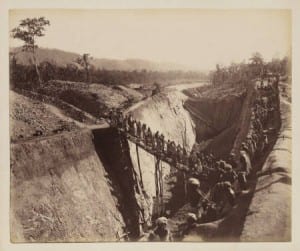
The Bengal-Nagpur Railway pioneered the way for future railroads and transportation in India. During the later half of the 19th century, British officials enlisted droves of Indian men and women as laborers for the construction of this railroad. This photograph illustrates just how many Indian workers the British solicited for manual labor and the hazardous working conditions that they were often faced with. In the photo, the laborers, at least one hundred strong, look up at the cameraman as they go about the tedious construction of the railroad. Men, women, and even younger children can be seen chiseling away at rock or carrying baskets of rubble. Another detail that catches your eye in the photograph is the haphazardly built bridge that these workers are using to cross over the ravine. It seems as if the British were more concerned with the timely, cost-effective construction of their railway than the safety or health of the Indians facilitating the work. Some questions that arise from the analysis of this photograph are approximately how much were native laborers compensated for their work and what was the mortality rate for them while working in these dangerous conditions.
http://digitalcollections.smu.edu/cdm/ref/collection/eaa/id/1503

